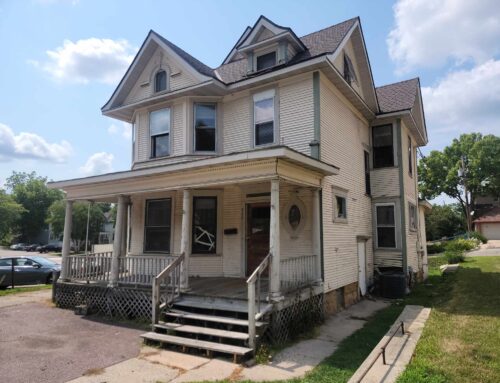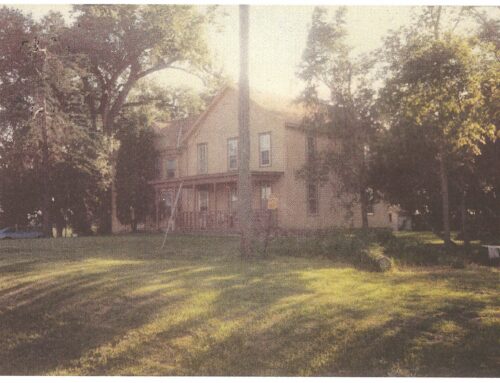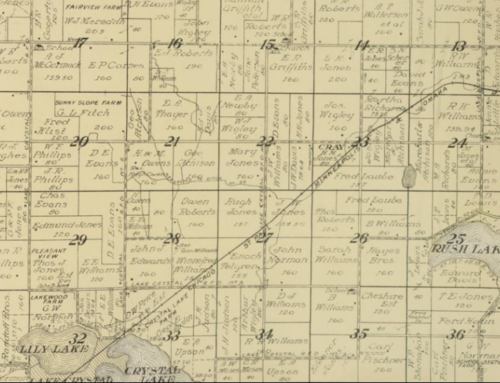In October 1901, a group of dedicated individuals gathered to discuss the forming of the Blue Earth County Historical Society. The purpose of this group was to gather records, photos and memories of the people and events of the past “for future generations.”
On November 7, 1901, with the signing of the constitution, the Blue Earth County Historical Society officially began. The thirty-three people who signed this document were ensuring the preservation of local history for generations to come. According to the constitution, the Historical Society would “collect, arrange and preserve a library of books, pamphlets, maps, manuscript, prints, papers…” and also “rescue from oblivion the memory of its early pioneers and to obtain narratives of their exploits, perils and adventures, together with their portraits and personal histories.”
The Society was formed in a time when many of the early settlers were passing away, hence there was a desire to preserve the early history of the county before it was too late. This was the same time that both Blue Earth County and Mankato were approaching their 50th anniversaries – the perfect time to reflect on the past and look to the future. The Historical Society founders and members would go on to play an important role in the five-day celebration remembering the settling of Mankato.
It’s interesting to discover how and why the Historical Society got started, but what about the people who made it happen? Who were those charter members? Those first officers for the Society? What inspired them to come together and begin to “collect, arrange and preserve” the history of Blue Earth County? Here is a look at a few individuals who at the turn of a new century were focused on preserving the past for the future.
Judge Daniel Buck was the driving force behind the new organization and hosted the early meetings. He also served as the Society’s first president and his daughter Laura Buck Abbott was among five women who signed the Constitution. He was born in 1829 in New York and arrived in Blue Earth County in 1857. He practiced law and was also a member of the State Legislature. In 1866, he was instrumental in securing the legislation that allowed for the State Normal School to be located in Mankato. The school opened in 1868 and is known today as Minnesota State University, Mankato.
By the time he retired in 1899, Buck’s résumé included a number of local positions including County Attorney, Blue Earth County Agricultural Society member, Mankato National Bank President and a member of the Minnesota Supreme Court. Judge Buck was also a member of the Territorial Old Settlers’ Society and wrote about the early history of the county, including a book on the US-Dakota War of 1862. Buck died in 1905 at the age of 75.
Thomas Hughes was another community leader at those first meetings and went on to serve as the Society’s first secretary. Hughes was also an attorney and was acclaimed as Blue Earth County’s historian having written several local histories including The History of Blue Earth County, Mankato: Its First 50 Years, History of the Welsh in Minnesota and History of Minneopa State Park. Born in 1854 in Ohio, Hughes came to Cambria Township a year later with his family. He went on to get his law degree and began working with Myron G. Willard in Mankato. Later, Hughes and his brother, Evan Hughes, formed their own law firm. Hughes was elected as the County Attorney in 1897. During the time he was secretary for the Society, he was the attorney for Mankato Mutual Building and Loan which later became the Mankato Savings and Building Association.
The regard Hughes held for history and the local community are evident from his many civic activities. Hughes served for many years on the BECHS’ board, was highly involved with the Minnesota Historical Society, a member of the Mankato Cemetery Association for almost 30 years and sat on the Minneopa State Park Board. Not only did Hughes sign BECHS’ Constitution in 1901, but he was also present in 1916 when the Society filed its Articles of Incorporation. Hughes was the only person who signed both documents and remained active in the Society until his death in 1934. His son E. Raymond Hughes followed in his father’s footsteps and served on the Society’s board as secretary beginning in 1927.
Charles A. Chapman was one of two vice-presidents selected by the Historical Society in 1901. A Harvard graduate, Chapman arrived in Mankato in 1857. He opened a surveying company with A.D. McSweeney and together they surveyed much of today’s downtown Mankato. Chapman was auditor for Blue Earth County, the first city engineer, and was heavily involved with the Mankato Board of Trade, Mankato Cemetery Association and Territorial Old Settlers’ Association. He played organ at the Presbyterian Church in Mankato and was known as an expert in Masonic lore. Chapman could always be counted on for a story of early days and events. He was remembered in his 1920 obituary as “one of the last remaining links which connect the past with the present.”
The other vice-president selected was Herbert C. Hotaling. Unlike many of the Society’s founders, Hotaling was born in Blue Earth County in 1865 to parents who were early pioneers. His early days were spent in Mankato and he then moved to Mapleton in 1888. Two years later he started the newspaper Mapleton Enterprise, later called the Blue Earth County Enterprise. From the beginning of his newspaper career, he played a prominent role in the affairs of his home city, county and state. Hotaling served on the Mapleton School Board for many years and was instrumental in getting a Carnegie Library in the community. In 1917, Hotaling was elected the 33rd president of the National Editorial Association, a position he held until his retirement in 1932. Hotaling passed away in 1938 after almost fifty years of bringing the news to Blue Earth County.
Phillip Mueller was the Society’s first treasurer. Born in Germany in 1829, Mueller immigrated to the United States in 1853, and arrived in Lime Township in 1856. Mueller farmed until 1890, when he and his family moved to Mankato where he remained until his death in 1906. Mueller was a founding member of the local chapter of the Ancient Order of United Workmen, a fraternal benefits organization which provided social and financial support after the Civil War.
Following the Semi-Centennial celebration in 1902, the Blue Earth County Historical Society saw little activity for over a decade. By 1916, however, history and preservation were on the minds of many. This was a prolific time for publications written about the history of the state and county. The Minnesota Historical Society and state historians put a call out to counties to begin to actively collect and preserve their history and maintain the historic records in central locations. This was especially important for organizations generating records related to the war effort – World War I.
With a renewed vigor and purpose, a group of interested community members, led by Judge Lorin Cray, filed the Blue Earth County Historical Society’s Articles of Incorporation on May 30, 1916, Memorial Day. The purpose of the Society was “the collection, preservation and publication of materials relating to the history of Blue Earth County.” Thirteen individuals signed that document and thus became charter members of the renewed organization. They also served as the first Board of Trustees, they were: Helen Hughes Hielscher, Lorin Cray, William Pay, Charles Wise, John Noe, John Andrews, John Hancock, Carolyn Robbins, James McConnell, Thomas Hughes, George Palmer, Horace Perrin and Felix Meagher.
Like the efforts in 1901, there were also a few community events in Mankato in 1916 that may have spurred the renewed interest for the Blue Earth County Historical Society. The Mankato Bazaar was held February 1-3, 1916 to raise money for the Red Cross and the war effort. Different booths displayed historic relics and a historical re-enactment was part of the event. Later that summer on July 4, 1916, the Mankato Historic Pageant was held to re-enact the history and development of Mankato. Many of the members of the Historical Society served on committees, wrote scripts or played different roles in the pageant. Over 500 people participated in the pageant that was viewed by over 15,000 people in Sibley Park.
Again, it’s interesting to see how and why the organization had a rebirth, but who made it possible? Here are the people that came together in 1916 to file the Articles of Incorporation and play key roles in the organization. Judge Lorin Cray led the 1916 reorganization and was elected president. Born in 1844 in New York, Cray came to Blue Earth County in 1859 with his family settling in Pleasant Mound Township. Cray served in the Civil War before a wound to his shoulder brought him back home. He opened a law office in Lake Crystal in 1875 and continued business there until 1887, when he moved to Mankato. During his time in Mankato, Cray was the attorney for two different railroads and National Citizen’s Bank. From 1900 to 1908, Cray served as a Judge for the Sixth Judicial Courts. He was elected in 1908 to be the president of National Citizen’s Bank.
At the Society’s first official meeting on Memorial Day, the Board and members discussed where to the keep the archives and relics that were collected. James McConnell offered space at the Normal School and it became the Society’s first collections storage. At that same meeting, President Cray “hoped the day was not far distant when the association would command a membership that would enable them to have a home of their own, where the many treasures that he felt sure would soon be assembled might form an educational center for all southern Minnesota, and that the names and deeds of the men and women who turned the tangled wilderness of this beautiful valley into smiling fields, and who laid the foundation of our schools and churches that are now our pride, may not pass into oblivion.”
Cray was active in the Territorial Old Settler’s Association, as well as the Blue Earth County Historical Society. Upon his death, Cray left money to the Historical Society to acquire a permanent home. Cray’s obituary in 1927, says it was his “firm desire to see the erection of a memorial building here to house historical relics. He took occasion in two or three public speeches to speak for such a project and offered an initial sum for the starting of it.” In 1938, the Historical Society purchased the Hubbard House for $11,500 to serve as the organization’s first permanent home. The purchase was almost completely funded by Cray’s bequest. Coincidently, the Hubbard House is a direct neighbor to the long-time home of Judge Cray.
The Historical Society’s vice-president in 1916 was James McConnell. Born in Pennsylvania in 1868 and an educator by trade, McConnell moved to Mankato in 1904 where he served as Superintendent of Public Schools. He went on to be a professor of American History and Government at the Mankato Teachers College from 1909-1919. McConnell was then appointed the Minnesota Commissioner of Education, serving for 14 years, until his death in 1933. At the Memorial Day meeting, McConnell spoke of preserving memories and events that “are the roots of the culture by which we project ourselves into a fuller and better appreciation of the day in which we live.”
Dr. Helen Hughes Hielscher was elected secretary in 1916. Helen Hughes was born in 1863 at Belford, Prince Edward Island, now a province of Canada. She received her medical degree from the University of Minnesota in 1896 and had her first medical practice in the city of Blue Earth. In 1900, Hughes Hielscher relocated to Mankato, where she and her sister Jane Hughes established the first maternity hospital. This hospital operated until St. Joseph’s Hospital incorporated a maternity department in its service.
Hughes Hielscher was the first female surgeon in Mankato and one of the first in Minnesota. In 1910 she married Dr. J.A. Hielscher and continued her practice until 1920, when she devoted her time to rehabilitation of returning WWI soldiers by organizing and shaping the American Legion Auxiliary. She established the Blue Earth County Welfare Association and was the first woman to occupy a position on the Minnesota Board of Health. Hughes Hielscher served as secretary of the Historical Society until 1927, when she was elected vice-president, a position she held until her death in 1935.
The first treasurer of the newly incorporated Historical Society was Felix K. Meagher. Meagher was born in Mankato in 1874 and attended Mankato High School. After school, Meagher worked as a cashier at National Citizen’s Bank; a place where his father was one of the founders. Meagher served as a cashier for 15 years before moving into higher management. While at National Citizen’s Bank, Meagher started Citizen’s Loan and Trust Company.
Outside of banking, Meagher was highly involved in the community being a member of the Chamber of Commerce, Kiwanis Club, Knights of Columbus and playing an active role in his church. Upon his death in 1925, many of the tributes about Meagher mentioned how personable he was and how dedicated he was to Mankato. “He was progressive and directly interested in all matters of a civic nature and a liberal contributor to enterprises that had their purpose of the up-building of his home community.”
At its inception, the purpose and goal of the Blue Earth County Historical Society was to collect and preserve local history “for future generations.” That means over 100 years ago the founders of the Society were thinking of us because, after all, we are all part of the “future generations.” Today, Society members and supporters proudly continue the mission and advancements of this long-standing organization.
For a quick timeline about BECHS, visit our About page.
For a brief history about the organization, watch this History In A Minute.







How does the old settlers association fit into all this? Their members erected the 1912 here were hanged 38 sioux Indians marker in 1912…50th anniversary of the event…and gifted it to the city, right?